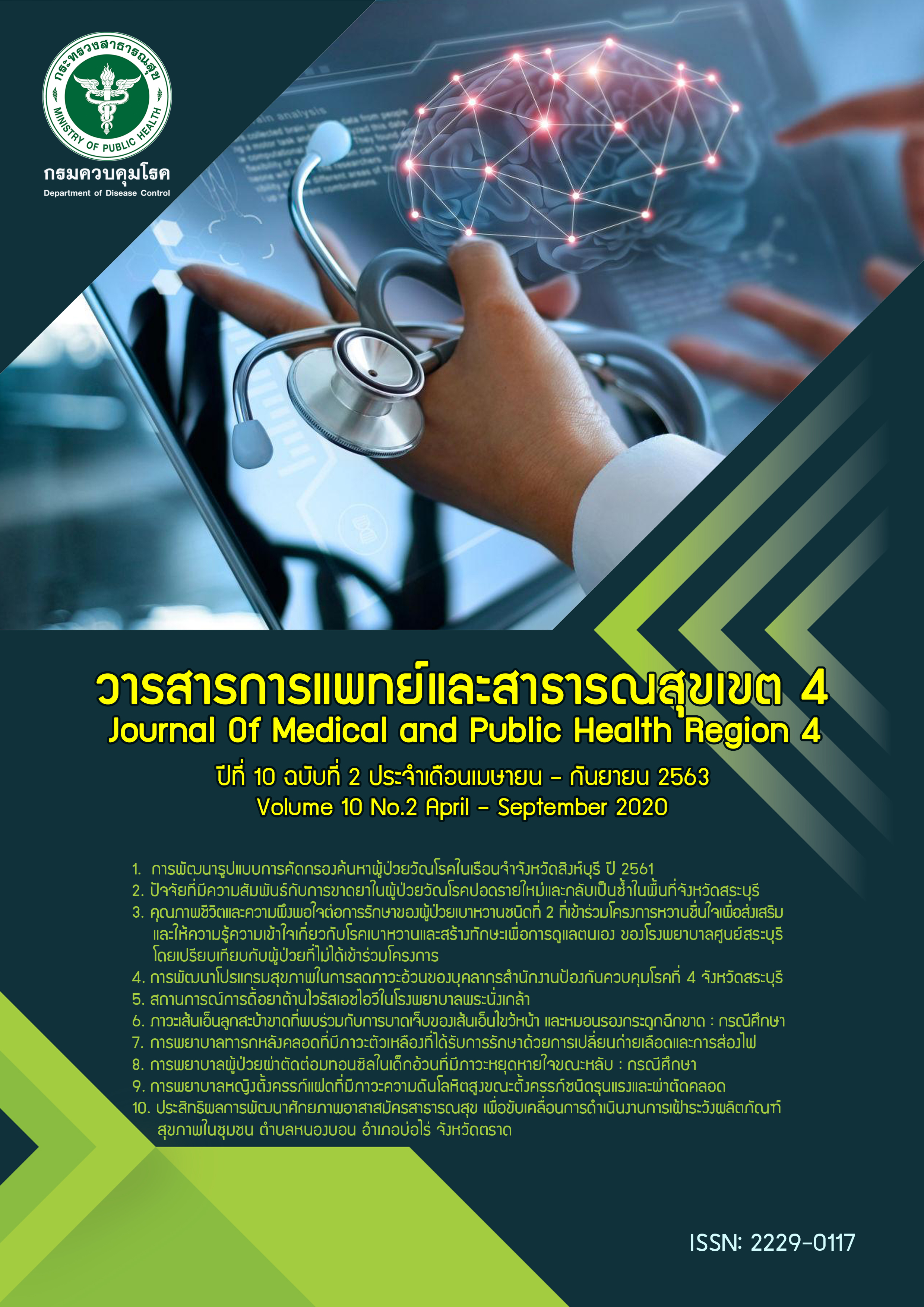Nursing Care of Neonatal Jaundice that Received Exchange Transfusion and Phototherapy
Main Article Content
Abstract
Neonatal jaundice is a common condition of neonates and the incident rate increases. The surveillance and proper management, especially in neonates who have high level of bilirubin help to prevent the complication of acute bilirubin encephalopathy and kernicterus. Standard treatment is usually started with phototherapy. Exchange transfusion is performed when the bilirubin continue rising to a level that encephalopathy is considered a threat. Case study, neonatal male 3,080 gram 5 days old with jaundice, The neonatal has body temperature 36.8 °C, pulse rate 130 beats per minute, respiration rate 48 breaths per minute, good suckling and active. Laboratory results showed that total serum bilirubin 26 mg/dl, Hematocrit (Hct) 50%. The neonatal received exchange transfusion and after exchange transfusion, total serum bilirubin was 18 mg/dl and Hct 48%. Continue phototherapy until total serum bilirubin levels are within acceptable range. On phototherapy 3 days, laboratory results showed that total serum bilirubin 12.5 mg/dl, Hct 50%. Finally, neonatal was discharged from pediatric ward and follow up at pediatric clinic in 2 days from discharge. Length of stay was 5 days.
Article Details
References
ฟองคำ ดิลกสกุลชัย, วิไล เลิศธรรมเทวี, อัจฉรา เปรื่องเวทย์, พรรณรัตน์ แสงเพิ่ม, สุดาภรณ์ พยัคฆเรือง, บรรณาธิการ. ตำราการพยาบาลเด็ก. พิมพ์ครั้งที่ 3. กรุงเทพมหานคร: ห้างหุ้นส่วนจำกัดพรี-วัน; 2555. น. 378-392.
2. จันทรมาศ เสาวรส. ภาวะตัวเหลืองในทารกแรกเกิด: ปัญหาที่ไม่ควรมองข้าม. ราชาวดีสาร วิทยาลัยพยาบาลบรมราชชนนีสุรินทร์ 2562; 9: 99-109.
3. กินรี ชัยสวรรค์ และ ธนพร แย้มสุดา. ปัจจัยที่มีความสัมพันธ์กับภาวะตัวเหลืองในทารกแรกเกิด. วารสารแพทย์นาวี 2561; 45: 235-249.
4. สุขุมาล หุนทนทาน. การศึกษาความชุก ความเสี่ยงทางคลินิก และผลการรักษาของทารกแรกเกิดที่มีภาวะตัวเหลือง โรงพยาบาลสมเด็จพระยุพราชด่าน. วารสารการพัฒนาสุขภาพชุมชน มหาวิทยาลัยขอนแก่น 2557; 2: 21-34.
5. สุชาดา ธนะพงศ์พร. ตัวเหลืองในทารกแรกเกิด: การพยาบาล. วารสารวิชาการมหาวิทยาลัยอิสเทิร์นเอเชีย 2557; 8: 63-73.
6. Bhutani VK, Johnson LH, Keren R. Treating acute bilirubin encephalopathy before it’s too late. Contemporary Pediatrics 2005; 22(5): 57-74.
7. American Academy of Pediatrics Steering Committee on Quality Improvement and Management. Classification of recommendations for clinical practice guideline, Pediatrics 2004; 114: 874-877.
8. ปิติพร ศิริพัฒนพิพงษ์. ภาวะตัวเหลืองที่สัมพันธ์กับการกินนมแม่. วารสารกุมารเวชศาสตร์ 2561; 57: 4-9.
9. หอผู้ป่วยทารกแรกเกิด สถาบันสุขภาพเด็กแห่งชาติมหาราชินี. สถิติทารกแรกเกิดตัวเหลืองปี พ.ศ. 2548-2550. กรุงเทพฯ สถาบันสุขภาพเด็กแห่งชาติมหาราชินี, 2551.
10. หอผู้ป่วยกุมารเวชกรรม โรงพยาบาลอินทร์บุรี. สถิติทารกแรกเกิดตัวเหลืองที่ได้รับการส่องไฟและเปลี่ยนถ่ายเลือด ปี 2559-2561. สิงห์บุรี โรงพยาบาลอินทร์บุรี, 2562.
11. สิริกัญญา เกษสุวรรณ. ปัจจัยทำนายการมีส่วนร่วมของมารดาในการดูแลทารกแรกเกิดตัวเหลืองที่ได้รับการรักษาด้วยการส่องไฟ. [วิทยานิพนธ์พยาบาลศาสตรมหาบัณฑิต]. ชลบุรี: มหาวิทยาลัยบูรพา; 2561.
12. Samara SD, Ana PN, Lislane K, Maria A, Francisca WB, Akemi IM. (2013). Nursing care for the newborn infant with jaundice in a maternity hospital. Journal of nursing 2013; 7: 7017-7023.
13. วรรษมน ปาพรม. ผลของโปรแกรมสนับสนุนและแอปพลิเคชั่นให้ความรู้ต่อพฤติกรรมการดูแลของผู้ดูแลทารกแรกเกิดที่มีภาวะตัวเหลืองและได้รับการรักษาโดยการส่องไฟ. วารสารพยาบาลสงขลานครินทร์ 2561; 38: 167-178.


